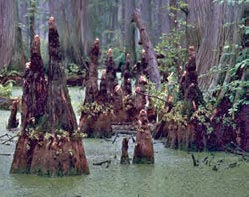Battle Creek Cypress Swamp, Calvert County
 Battle Creek Cypress Swamp is one of the northernmost stands of bald cypress trees. These unusual conifers shed their feathery leaves in the fall. In winter, their gray, shreddy bark distinguishes bald cypress from other deciduous trees. A small, wooden boardwalk snakes around these relics of the past. Distinctive, knobby cypress "knees" emerge from the water near the boardwalk. On spring mornings, visitors are serenaded by birds such as the golden-colored Prothonotary warbler and the ground-foraging Louisiana waterthrush. In late summer, visitors can enjoy splashes of color provided by cardinal-flower and the Threatened red turtlehead (Chelone obliqua). In the evening, one may also hear the quick trill of the arboreal gray treefrog. Visitors can enjoy several hiking trails that lead through the property.
Battle Creek Cypress Swamp is one of the northernmost stands of bald cypress trees. These unusual conifers shed their feathery leaves in the fall. In winter, their gray, shreddy bark distinguishes bald cypress from other deciduous trees. A small, wooden boardwalk snakes around these relics of the past. Distinctive, knobby cypress "knees" emerge from the water near the boardwalk. On spring mornings, visitors are serenaded by birds such as the golden-colored Prothonotary warbler and the ground-foraging Louisiana waterthrush. In late summer, visitors can enjoy splashes of color provided by cardinal-flower and the Threatened red turtlehead (Chelone obliqua). In the evening, one may also hear the quick trill of the arboreal gray treefrog. Visitors can enjoy several hiking trails that lead through the property.
Battle Creek Cypress Swamp encompasses about 100 acres of cypress swamp and surrounding upland woods. It was purchased in 1977 by The Nature Conservancy and is currently leased and operated by Calvert County Parks and Recreation. The special habitat at Battle Creek was recognized as a National Natural Landmark in 1965.
A Living Fossil

Bald cypress is typically a sub-tropical tree of blackwater swamps and cypress domes in the southeast. Prior to the last Ice Age, when mammoths roamed the State, bald cypress was more widely distributed. An ancient bald cypress trunk was unearthed during construction of the M & T Stadium in Baltimore. Scientists believe that as the climate warmed, bald cypress re-established at Battle Creek. Individual cypress trees can live for over 1,500 years, and a stroll down the boardwalk recalls a distant era when crocodiles and giant white sharks stalked our shores.
Cypress Specialists
Three types of moths identified at Battle Creek feed only on bald cypress leaves, including the rare cypress sphinx moth (Isoparce cupressi). The highly specialized diet of their larvae greatly restricts the distribution of these species. Adult moths fly at night, and larvae feed high in the canopy, making them difficult to observe. Further surveys are needed to determine their current status.
Click here for a Print Version of this map.

Directions
From Washington, DC: Travel I-95/495 (Capital Beltway) to Exit 11 and head south on MD 4 into Calvert County. After about 30 miles (from the Beltway), continue past Prince Frederick another 2.3 miles to MD 506 (Sixes Road) and turn right (west). After 1.8 miles, look for the sign and turn left onto Gray's Road. The entrance to the nature center will be on your right in approximately 0.25 mile.

Driving directions and aerial views open with Google Maps. For the aerial view button, if an aerial view does not open by default, click on the Satellite icon in the upper right corner and Google Maps will switch to an aerial view of the Natural Area.

Acknowledgements:
Scenic View of Bald Cypress Swamp, photo by Kerry Wixted.
"Knees" of bald cypress jut above the water. Photo by USFWS
Wildlife Collage: (left to right)
The colorful caterpillars of the highly rare cypress sphinx moth feed chiefly on bald cypress trees. After several molts, the larvae dig shallow burrows from which they will later emerge as adults. Photo by: Charlene Nutter.
Listen for the cheerful "sweet" song of the male Prothonotary warbler in spring. The birds were named after the Roman Catholic Prothonotary clerks, whose robes were a bright yellow. Phoito by: Wikimedia Commons.
Gray treefrogs are superb climbers. Their color can change from gray to green or brown, depending on their environment or activity. Photo by: Kerry Wixted.
Photo Collage: (left to right)
Red turtlehead is so named because its flower resembles
a turtle's head. The plant's genus name (Chelone) is Greek for
tortoise. Photo by: Kerry Wixted.
Cardinal-flower brings a vibrant splash of color to the swamp in summer. Cardinal-flower brings a vibrant splash of color to the swamp in summer. Photos by: Wikimedia Commons.